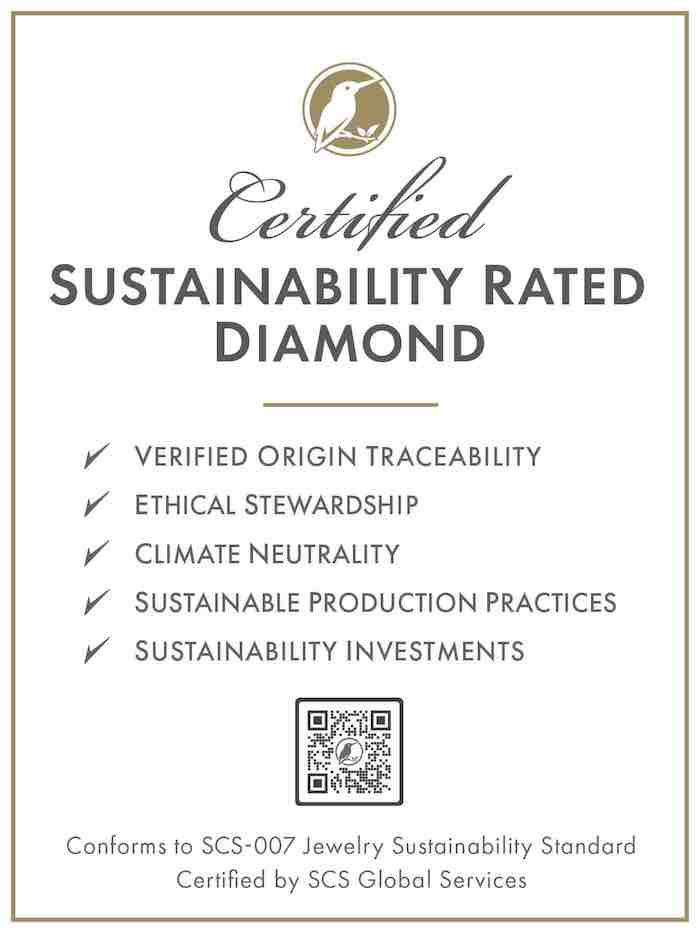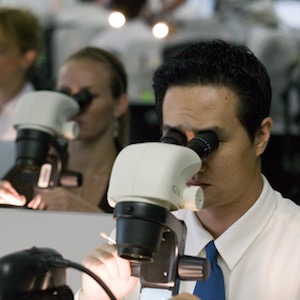
Brandee Dallow (pictured), a highly regarded industry executive who has worked for the Responsible Jewellery Council (RJC), De Beers, and Rio Tinto, is joining SCS Global Services as vice president of sustainability for luxury goods, JCK can report.
The news comes as more companies are signing on to SCS’ Certified Sustainability Rated Diamond program which audits gems and their producers against a 133-page standard. WD Lab Grown Diamonds was the first to get certified, and growers Green Rocks, Lusix, and Meylor Global are among the next in line.
Yet the program is meant to certify more than lab-grown diamonds; it’s also open to natural diamonds, colored stones, and recycled gems. But so far, no miners have signed up.
Which is puzzling. Given the negative perceptions some consumers have about diamond mining, being able to sell “certified sustainably rated” mined gems (the label has been changed from “certified sustainable”), could solve a lot of producers’ problems—though, granted, they have to pass the audits first.
When I asked Stanley Mathuram, executive vice president of SCS, why miners have not participated, he was puzzled, too, but hopes Dallow will assist with outreach.
So, I asked the miners. Those I talked to—all of whom wished to remain anonymous—felt the RJC and the Initiative for Responsible Mining Assurance (IRMA) offer better solutions for their companies.
They recognized the importance of lab-grown companies having their eco-credentials certified instead of just proclaiming them. They agreed SCS, which conducts audits for both RJC and IRMA, is a reputable organization.
But they had questions about the standard, its development, and its tracking system.
One was uncomfortable with SCS devising the standard and then auditing against it. “You can’t be both judge and jury,” this person said. “This feels like a business venture.” This person noted that the RJC has been accredited by ISEAL, which is like the “Olympics for standards,” as another source put it.
One miner didn’t see the logic in having the same standard for both natural and lab-grown: “It doesn’t make sense to compare a product made in a factory with one that comes out of the ground. They are different processes.” This person complained miners weren’t consulted when the standard was being developed—only asked for input afterward—and noted a lot of SCS’ mining standard seems based on the one already developed by RJC.
And while no one said it outright, I sensed that, given the ongoing hostilities between the sectors, mining companies didn’t want their products to be placed on the same level as lab-growns. Currently, the RJC has no standard for lab-grown diamonds, though whether it should have one has been the subject of internal debate. (For what it’s worth, I feel it should.)

SCS’ Mathuram says he’s heard these objections, many times. He counters that the criteria was devised by SCS’ nonprofit arm, which adheres to the protocols set by the American National Standards Institute—which sets standards for setting standards. (Yes, such a group exists.)
While no current mining employees participated in the standard development, it did attract some mining vets, NGOs, and experts familiar with the sector. Mathuram points out the draft document was open for comments—it received over 500, some “not polite”—and will be continually revised.
In SCS’ view, its standard falls somewhere between RJC’s and IRMA’s. The IRMA standard is notoriously tough—too strict for diamond mines, Mathuram says.
“IRMA is really meant to go after lithium and copper and operations like that. It’s overkill for a diamond mine. Diamond mining is a cleaner form of operation. The diamond mines don’t have the issues with extensive requirements for water discharge, or the air quality issues.”
On the other hand, while RJC measures environmental impact, it doesn’t commit users to climate neutrality, like SCS does.
RJC also doesn’t allow product-based claims, because it doesn’t have certified chains of custody for diamonds. SCS has a tracking scheme, though it’s not the long-sought-after method to scientifically monitor every diamond down the pipeline. It makes companies send a sample of diamonds to Western Australia–based Source Certain, which uses laser ablation to identify their impurities, or their “chemical fingerprint.” That fingerprint doesn’t change, even when a diamond is polished, Source Certain says. Growers’ samples have to be continually updated, as their “recipes” change.
After Source Certain identifies the fingerprint, SCS conducts periodic/random tests at the retail and factory level to ensure the growers’ sample matches the polished. And while every diamond isn’t tested, the gems are also tracked by Sarine’s Diamond Journey. Mathuram says this kind of sporadic sampling is common in other industries SCS certifies, as it’s too cumbersome to test, say, every piece of shrimp. He adds he’s “technology-agnostic” and open to other tracking methods.
As far as both kinds of diamonds having the same certification—an idea that emerged in the comment period—Mathuram says that while growers and diamond miners are judged on different criteria, they must both attain a net-zero eco-footprint.
“Right now, you have one side saying [the miners] got a hole in the ground so they must be a holocaust. The other one says [the growers are] using [a lot of energy] so they are another holocaust. That is an unproductive discussion.
“If you go climate neutral, that means that, at the end of the day, whoever is purchasing your diamond can be assured that you have negated its footprint.”
(I lack the space, or expertise, to delve into the difference between a climate-neutral certification versus a carbon-neutral seal, but carbon neutrality generally focuses on eliminating CO2 and arriving at net-zero carbon emissions, while climate neutrality targets other types of pollutants and looks at other environmental issues. Both use a combination of mitigation and offsets to arrive at net-zero impact, which is not the same as zero impact. There’s more on the differences here. Natural Capital Partners, which has certified Diamond Foundry as carbon neutral and is working with Pandora, tells JCK that its “CarbonNeutral certification is highly regarded as a credible mark for climate action across all the greenhouse gases” and is being used by Amazon’s Climate Pledge Friendly initiative.)
SCS also offers something that other groups do not: a consumer-facing component. RJC and IRMA are mostly business-to-business standards.
This doesn’t mean that the natural diamond industry—or for that matter, other jewelry products—aren’t interested in a consumer label. Currently, companies that pass the RJC’s chain-of-custody gold certification can call their gold “RJC-certified.”
They can’t do that for diamonds yet, but it’s something the RJC is looking at, along with chain-of-custody certification. Executive director Iris Van der Veken says she wants to make sure any standard, particularly the chain of custody, is “done right. We want it to be credible and not overpromise.”
That’s commendable. If miners truly have qualms about the SCS program, they shouldn’t participate. But if they are simply shying away because of the worn-out natural vs. lab-grown feud, they should reconsider.
While miners may consider natural diamonds “above” lab-growns, some consumers don’t see them that way; in fact, some view mined diamonds as “less than” because they’re supposedly less eco-friendly. While those claims have little basis, and it’s idiotic to make sweeping generalizations about huge industries in any case, those perception exist. In the end, consumers call the shots. Miners are now at a disadvantage. The SCS certification potentially levels the playing field.
Soon certified sustainably rated lab-grown diamonds will start appearing at retail counters. Miners should ask themselves: Why should growers be the only ones to use that label when they can, too?
Correction: SCS’ label is no longer “certified sustainable,” but “certified sustainably rated.” Source Certain examines “chemical fingerprints,” not “footprints.”
(Top photo courtesy of Brandee Dallow)
- Subscribe to the JCK News Daily
- Subscribe to the JCK Special Report
- Follow JCK on Instagram: @jckmagazine
- Follow JCK on X: @jckmagazine
- Follow JCK on Facebook: @jckmagazine






